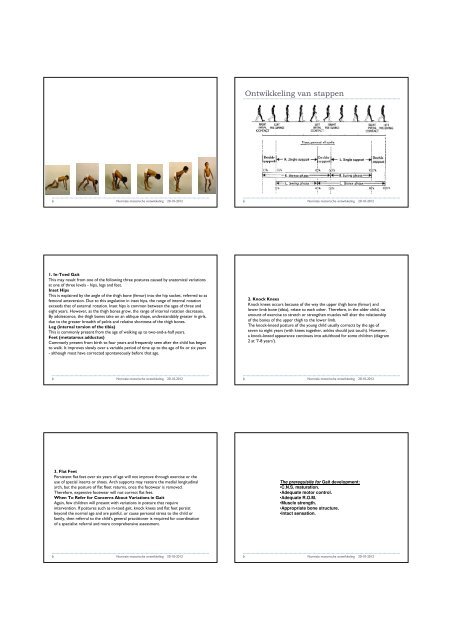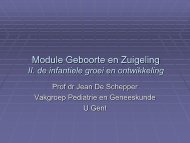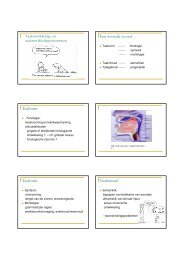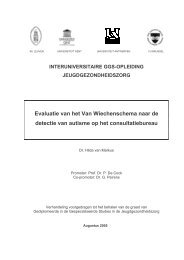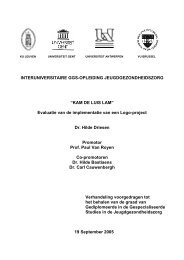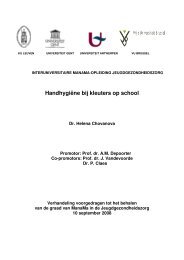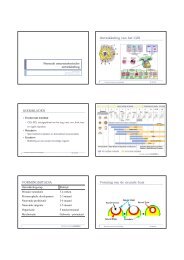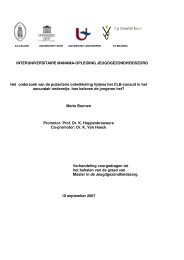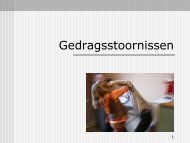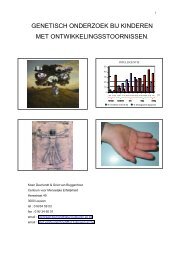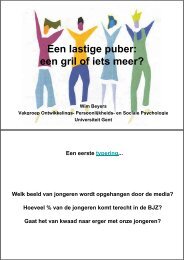Normale neuromotorische ontwikkeling_Els Ortibus.pdf
Normale neuromotorische ontwikkeling_Els Ortibus.pdf
Normale neuromotorische ontwikkeling_Els Ortibus.pdf
You also want an ePaper? Increase the reach of your titles
YUMPU automatically turns print PDFs into web optimized ePapers that Google loves.
<strong>Normale</strong> motorische <strong>ontwikkeling</strong> 20-10-2012<br />
1. In-Toed Gait<br />
This may result from one of the following three postures caused by anatomical variations<br />
at one of three levels - hips, legs and feet.<br />
Inset Hips<br />
This is explained by the angle of the thigh bone (femur) into the hip socket, referred to as<br />
femoral anteversion. Due to this angulation in inset hips, the range of internal rotation<br />
exceeds that of external rotation. Inset hips is common between the ages of three and<br />
eight years. However, as the thigh bones grow, the range of internal rotation decreases.<br />
By adolescence, the thigh bones take on an oblique shape, understandably greater in girls,<br />
due to the greater breadth of pelvis and relative shortness of the thigh bones.<br />
Leg (internal torsion of the tibia)<br />
This is commonly present from the age of walking up to two-and-a-half years.<br />
Feet (metatarsus adductus)<br />
Commonly present from birth to four years and frequently seen after the child has begun<br />
to walk. It improves slowly over a variable period of time up to the age of fix or six years<br />
- although most have corrected spontaneously before that age.<br />
<strong>Normale</strong> motorische <strong>ontwikkeling</strong><br />
20-10-2012<br />
3. Flat Feet<br />
Persistent flat feet over six years of age will not improve through exercise or the<br />
use of special inserts or shoes. Arch supports may restore the medial longitudinal<br />
arch, but the posture of flat fleet returns, once the footwear is removed.<br />
Therefore, expensive footwear will not correct flat feet.<br />
When To Refer for Concerns About Variations in Gait<br />
Again, few children will present with variations in posture that require<br />
intervention. If postures such as in-toed gait, knock knees and flat feet persist<br />
beyond the normal age and are painful, or cause personal stress to the child or<br />
family, then referral to the child's general practitioner is required for coordination<br />
of a specialist referral and more comprehensive assessment.<br />
<strong>Normale</strong> motorische <strong>ontwikkeling</strong><br />
20-10-2012<br />
Ontwikkeling van stappen<br />
<strong>Normale</strong> motorische <strong>ontwikkeling</strong><br />
20-10-2012<br />
2. Knock Knees<br />
Knock knees occurs because of the way the upper thigh bone (femur) and<br />
lower limb bone (tibia), relate to each other. Therefore, in the older child, no<br />
amount of exercise to stretch or strengthen muscles will alter the relationship<br />
of the bones of the upper thigh to the lower limb.<br />
The knock-kneed posture of the young child usually corrects by the age of<br />
seven to eight years (with knees together, ankles should just touch). However,<br />
a knock-kneed appearance continues into adulthood for some children (diagram<br />
2 at '7-8 years').<br />
<strong>Normale</strong> motorische <strong>ontwikkeling</strong><br />
The prerequisite for Gait development:<br />
•C.N.S. maturation.<br />
•Adequate motor control.<br />
•Adequate R.O.M.<br />
•Muscle strength.<br />
•Appropriate bone structure.<br />
•Intact sensation.<br />
20-10-2012<br />
<strong>Normale</strong> motorische <strong>ontwikkeling</strong><br />
20-10-2012


